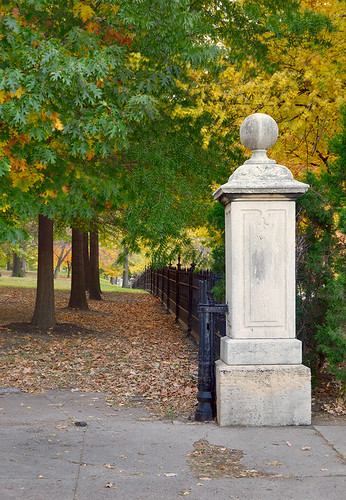
An entrance to the park, designed by Francis Tunica. These photos were taken on November 1st, All Saints Day, at the peak of Autumn color.
According to a history of the neighborhood:
Since Saint Louis’s beginning as a French village in 1764, the land which is now Lafayette Square had been a common pasture for village livestock and had never been privately owned. These commons became encampments for bands of criminals who would attack and rob area travelers. In 1835, now under American rule, Mayor Darby gained permission from the state legislature to begin selling the commons to drive the criminals out. When the city began to sell the common pasture, the Board of Aldermen set aside about thirty acres for community recreation. The square park was bordered by a street on each side, with the southern street called Lafayette in honor of General Marie-Joseph-Paul-Roch-Yves-Gilbert du Motier, Marquis de La Fayette, who had visited Saint Louis a few years previous.
In 1837 a real estate panic forced many who had bought land surrounding the Square to cease their payments causing the land to revert to the City. In the early 1850s, after courts had adjudicated the ownership of these properties, several prominent Saint Louisans bought most of the land bordering the southern end of the Park. These families built expensive homes along on Lafayette Avenue and secured state legislation preventing “any nuisance within a distance of 600 feet from the Park.” On November 12, 1851, the park was dedicated as “Lafayette Square” by City Ordinance 2741. By 1856, real estate developers had begun to sell lots on the western edge of the park—along Missouri Avenue—and by 1858 lots on the east side—Mississippi Avenue—were being sold. On Park Avenue—running along the north edge of the Square—the lots were developed by the 1870s.Natural disaster began this neighborhood's period of decline:
On May 27, 1896, Lafayette Square was largely destroyed by a tornado. The tornado did millions of dollars worth of damage, and killed many. The tornado uprooted nearly all of the trees in the Park as well as the trees on Benton Place, damaged the fence, destroyed the bandstand, destroyed the Union Club and the Methodist church at Jefferson and Lafayette Avenues, crippled the Presbyterian and Methodist churches, tore the roof off the Unitarian church, and crippled or destroyed many homes on the Square. Although some residents gave up on the neighborhood and moved away, others began to rebuild and by 1904 the Square had improved enough “to earn special commendation from foreign landscape architects who were visiting the World’s Fair.”
In 1923, the Missouri Supreme Court declared the 1918 residential zoning ordinance unconstitutional (see City of St. Louis v. Evraiff, 256 S.W. 489 (Mo. 1923)) and businesses began to purchase lots in the area. What the tornado of 1896 had begun, and the encroachment of gas stations and grocery stores continued, the Great Depression accelerated. By the end of World War II, the Square’s half-century of decline was complete. At this time, the neighborhood that was once the jewel of St. Louis had reached the low point in its history by becoming “a pocket ghetto of the unfortunate and poor,” known as “Slum D.”
The fortunes of this area reversed in the late 1960s, when dedicated restorationists moved into the neighborhood. Less than a decade earlier, Victorian architecture was despised and vast numbers of buildings of that era were being destroyed on an scale unprecedented outside of warfare. These urban pioneers often relied on their own labor to restore the buildings, which were then in great disrepair and available at extremely low cost; they are now quite valuable.
These cannons are from the British warship Acteon, which sank while attacking Fort Moultrie during the Revolutionary War.
Statue of Thomas Hart Benton (1782 - 1858), a Democrat and United States Senator from 1821, the year Missouri gained Statehood, to 1851, when he lost support due to the slavery controversy. He was one of the chief architects of the policy that became known as "Manifest Destiny": that the United States was to become a vast, continental power. On the pedestal of this statue is a phrase he used during his stump speeches: "There is the East. There is India," as he pointed to the west. He was a proponent of Jeffersonian Democracy, gold specie money (as opposed to paper currency and bank debt), and although a slave owner, he opposed its expansion into the new territories; this opposition, and that he was also a staunch Unionist, ended his career in the Senate.
This statue was erected in 1868 and is by Harriet Goodhue Hosmer, who studied anatomy at the Saint Louis Medical College, and was a member of a women's group of neoclassical sculptors in Rome, Italy.
Trade through Saint Louis in the early part of the century exchanged manufactured goods from Britain and New England for bartered furs from the Indians and hard money from Mexico. Not relying on banks and especially debt, the prosperity of Saint Louis had a steady character.
A statue of George Washington (1732-1799), first President of the United States, installed in 1869. This is one of six copies of the statue by Jean-Antoine Houdon (1741 -1828), a French neoclassical sculptor known for his portraits of Enlightenment figures. Houdon was a member of Les Neuf Sœurs, a Grand Orient masonic lodge in France organized in 1776 to support the American Revolution; he was persuaded by Benjamin Franklin, master of the lodge, and Thomas Jefferson, envoy to the lodge, to come to America. Washington sat for Houdon in 1785, which included plaster and clay masks from life; Houdon also made casts of Jefferson and Franklin, which led to other famous sculptures.
Washington is shown here next to the fasces lictoriae, a symbol of power and unity in Ancient Rome, much used in governmental architecture in the United States.
As a Federalist, Washington supported a strong central government with extensive powers of taxation and a central bank. He promoted national civic virtue, and warned against sectionalism, partisanship, and involvement in foreign wars.
Lafayette, after whom this neighborhood is named, served with distinction under Washington during the Revolutionary War.

This photo of an old police station in Lafayette Park dates from April of this year. I was unable to take a fresh photo, because another wedding party was being photographed here. Known as the Park House, this was built in 1867 and expanded in 1870. The building is smaller than it appears, since it incorporates detail on a scale which perhaps is more properly found on a larger structure.
A frog sculpture in the children's playground, by Robert Cassilly, who also founded the City Museum in downtown.
A swan house on an island in the park's lake.
A gazebo, the third to sit on this spot. It can be rented for events.
A low-quality photo of an elegant wedding party being photographed in the park.

This photo of an old police station in Lafayette Park dates from April of this year. I was unable to take a fresh photo, because another wedding party was being photographed here. Known as the Park House, this was built in 1867 and expanded in 1870. The building is smaller than it appears, since it incorporates detail on a scale which perhaps is more properly found on a larger structure.
This part of the park is the Rockery, with an iron bridge spanning a small lake. The wedding party shown above was photographed at this bridge.
A close-up of the bridge, with a blurry glimpse of the groom on the right.
A nice planter. In the background is seen a section of the wrought-iron fence around the park, installed in 1869. At one time, this kind of fencing was very common in Saint Louis, but much of it was scrapped during World War II. Local residents fought hard to preserve this fence during that time. Behind the fence are homes in the Second Empire style (I think. Corrections appreciated).
On Park Avenue is a grand mansion, facing the north side of the park.
A row of businesses, northeast of the park.
Nicely-restored townhouses along Mississippi Avenue, facing the park from the east.
Residents of this neighborhood tend to be politically liberal, and they reflect in some ways the attitudes of the founders of Lafayette Square, who were mainly wealthy and fashionable mainstream Protestants or freethinkers.
There is no Catholic church in this neighborhood, nor did any exist here during the neighborhood's heyday. Saint Joseph (Lithuanian) Catholic church was here from 1915 to 1970, a period when this neighborhood was in sharp decline and impoverished. The church and rectory still exist, and are for sale; I did not take a photo of it because I didn't know of its history at the time. The nearest existing Catholic church in the area is Saint John Nepomuk, located about half a mile to the east of the park. [Update: Click here for my photos of the old Saint Joseph Church; this neighborhood does have a chapel of the Society of Saint Pius X, a group currently in imperfect communion with the Holy See.]
This is a "half-flounder" style building, an unusual type found primarily in Saint Louis and Alexandria, Virginia.
A shop, on the corner of Hickory Street and Mississippi Avenue.
Saint Louisians were incredulous about moving to Lafayette Square during its initial development. For this area was separated from the existing city, being south of the Mill Creek Valley and Chouteau's Pond, and so was quite inconvenient to the rest of town.
Disasters changed public opinion. In 1849, a cholera epidemic wiped out 10% of the city's population, and a steamboat explosion and subsequent fire destroyed much of the older part of town. Obviously, having too large of a population living in close confines increased the risk of such disasters happening again.
In response, new neighborhoods sprang up, including Lucas Place (now destroyed) and Lafayette Square. New horse-drawn omnibus lines served as transportation into downtown, and some of the nation's earliest sewer and water systems were developed as public health measures. Cemeteries were also relocated to outlying areas.
A former shoe factory, two blocks north of the park, is now an apartment building.
At the far end of that building, a view of downtown Saint Louis.
Lafayette Park sits above the Mill Creek Valley, and roads leading down to Chouteau Avenue are somewhat steep; this large retaining wall shores up the Benton Place development above. Somewhat mysteriously, there is a door in this wall, now cemented shut.
If I recall properly, the lower part of this building dates from the colonial period.
Next door.
The old Desloge mansion on Benton Place, the first private street in Saint Louis. This block is one of my sister-in-law's favorites.
Other homes on Benton Place.
This fountain, now a planter, is also on Benton Place. This photo is from April of this year.
For sale.

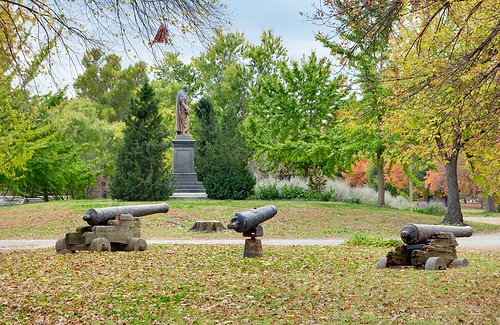

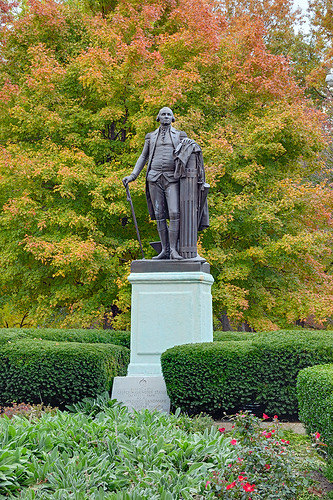
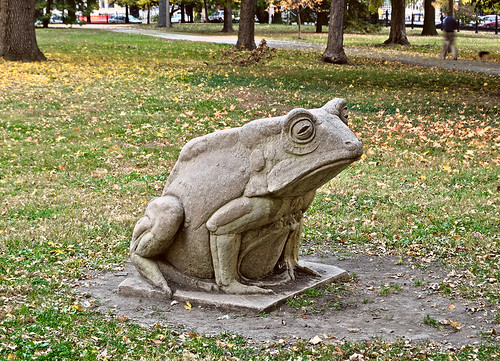

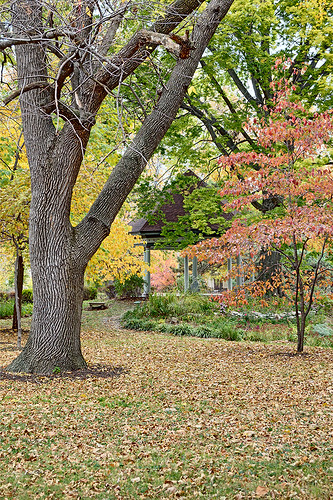
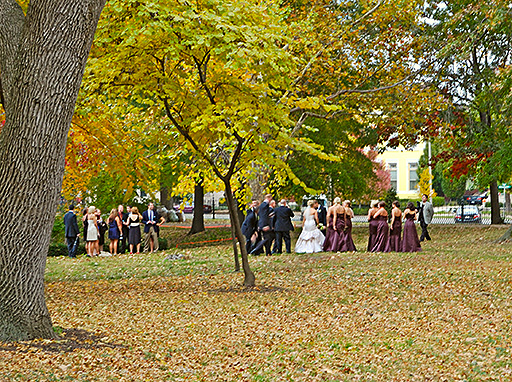
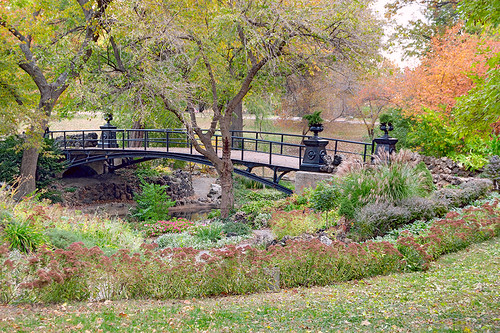
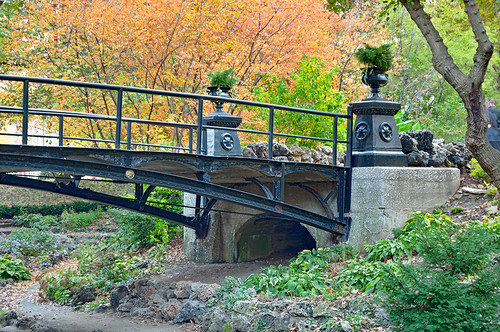
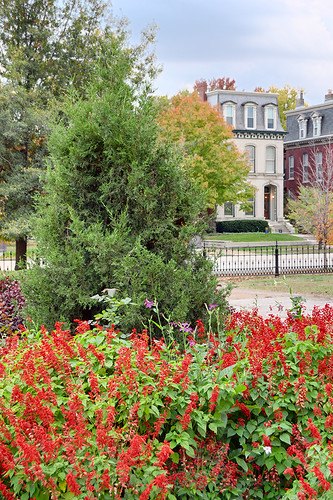
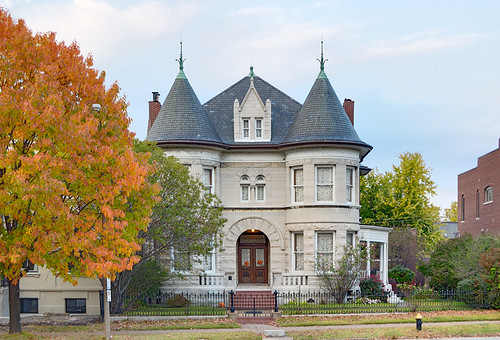
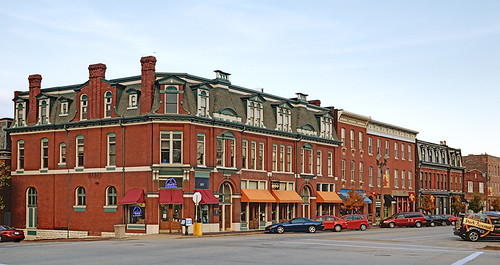
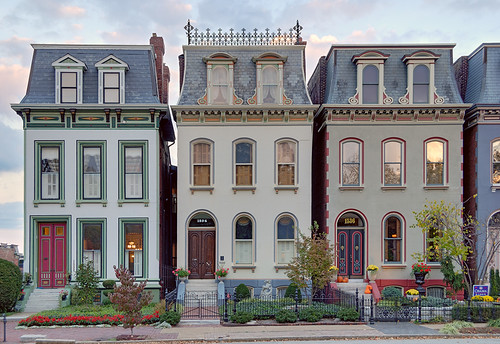
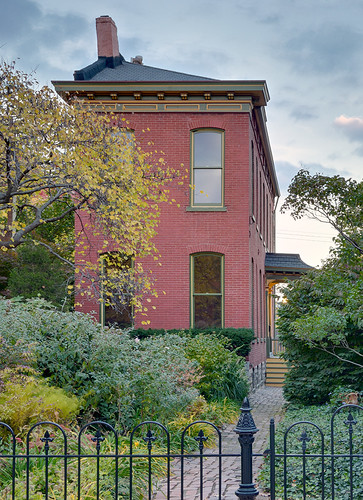
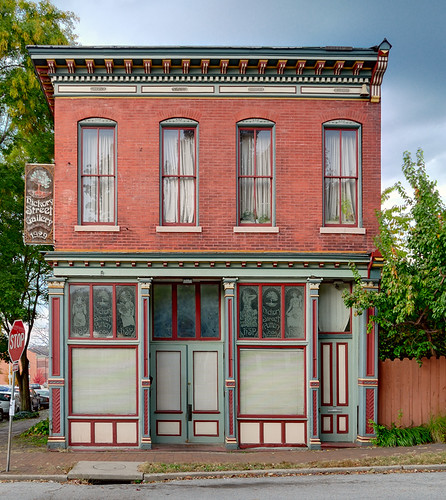
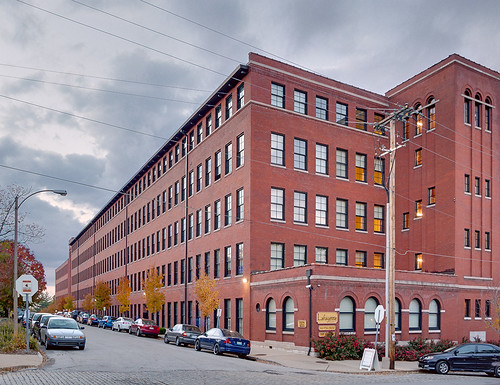
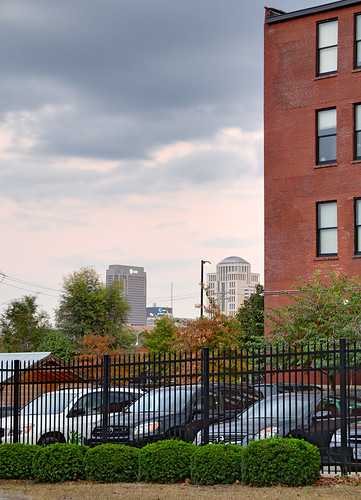
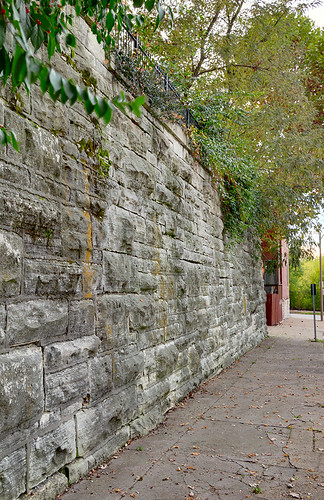
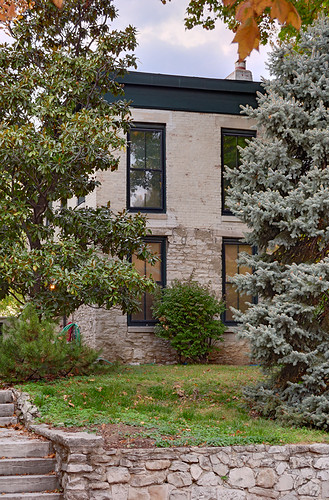

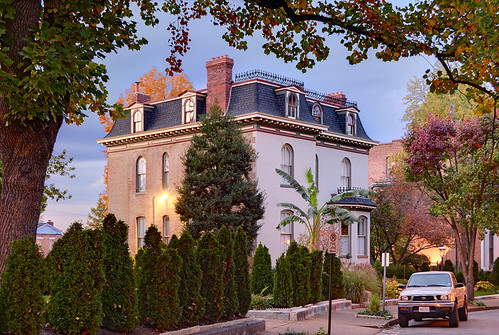

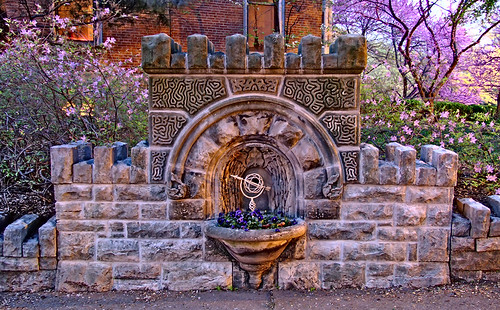


And do poor people still live in these houses? If not, where do they live?
ReplyDeleteIrene,
ReplyDeleteI would think that some of the apartment rentals hereabouts are inexpensive, and last I've heard, about 10% of the property here has not been refurbished. Some neighborhoods become wealthier, while others get poorer, with the poor generally moving into newer neighborhoods. Some neighborhoods, having always been mixed income, like Soulard, have become quite stable and affordable for most, but the characteristic architecture of Lafayette Square makes mixed income rather more difficult, especially since it has a strict restoration code, making upkeep far more expensive.
I've noticed that the people who complain the most about gentrification are the gentrifiers. I can't blame them, though: they find a really cool - and cheap - neighborhood, but then it gets so expensive that they can't live there anymore.
Local politicians of all parties have had historically a very heavy hand when dealing with poor neighborhoods. "Urban renewal" of the 1950s wiped out square miles of the city, and a lot of it remains empty to this day. Nowadays, poor neighborhoods are being leveled with alarming frequency by the private use of eminent domain - politicians say it is both good for business and for increasing tax revenue. The poor have to live somewhere, so they just move: but to get around this problem, Planned Parenthood kills the poor before they are born, and universal healthcare will likely kill them when they get old.
As always, I love your photos - but I must offer one correction to your commentary. There is a Catholic Church in the Lafayette Square neighborhood, St. Mary's Assumption, located at the corner of Dolman and Hickory Streets.
ReplyDeleteIn 1908, this former Episcopalian church was sold to Eastern European Catholics and became a Ruthenian (Byzantine) Catholic Church. They remainded at this location for several decades.
Sometime in the mid 1990's, St. Mary's Assumption was purchased by the Society of St. Pius X, an order of priests who offer the traditional Latin mass exclusively. According to several long-time residents in this little corner of the Lafayette Square neighborhood, St. Mary's Assumption being re-opened had a stabalizing effect on the block before other renovation/rehabbing efforts began. (The arrival of the SSPX predates Eleven Eleven Mississippi, Gast Haus, Eden Lofts, Sqwires and most of the other newer businesses in the northeastern quadrant of Lafayette Square.)
Mark, the poor die early now of very treatable diseases because they have NO health care!How do you make the olympian jump to the belief that we will be "killing" them early if we have universal health care???? I am curious...tell us exactly what type of neighborhood you reside in, be very specific about the ethnicity and economics of your neighbors....
ReplyDeleteSusan,
ReplyDeleteYou are correct, and I had forgotten about the SSPX chapel.
According to my map, it technically is in the Peabody neighborhood, although with the recent construction of the Truman Parkway, the half-block on which the chapel sits is cut off from the rest of that neighborhood, and so geographically is more naturally in Lafayette Square.
The SSPX chapel is not under the obedience of the local ordinary.
For readers who may not know, the Society of Saint Pius X was founded by Archbishop Marcel Lefebvre, who opposed many of the disastrous reforms following the Second Vatican Council. Lefebvre and his bishops were excommunicated for disobedience by Pope John Paul II in 1988, although Pope Benedict XVI stated that this excommunication does not extend to the Society's priests or followers.
The legal status of the SSPX is very complicated, but there tends to be two views:
1. The SSPX is a group of dangerous schismatics, disloyal to the Church.
2. Archbishop Lefebvre is a new Athanasius. As the ancient Saint battled the heresy of Arianism, so Lefebvre battled the heresy of Modernism.
Puma,
ReplyDeleteI was being sarcastic.
However, I think that the Obama Administration will almost certainly make euthanasia the law of the land - for it is a solid part of the zeitgeist.
One of my great-great grandmothers was euthanized in Germany for being too old. Nearly the entirety of my Eastern European relations were euthanized for the crimes of being Polish and Catholic. All this was done by the most enlightened and progressive nation in Europe; the people wanted change, and they got it. However, Obama's form of rule will more likely be a 'soft' totalitarianism: see "Brave New World" for a fictional description of this kind of regime.
Also, I think that the Catholic Church will be prevented from continuing its mission to serve the sick and poor, due to removal of conscience clauses.
Government work in general is inefficient and expensive - and so some sort of rationing will almost certainly be called for. The question is, which groups will be rationed out of the system?
Mark, I really admire your photography, desire to preserve and restore church buildings in St. Louis and what seems to be a geniune love for the historic St. Louis. I simply cannot distinquish between what you say is sarcastic and what you truly believe. I am going to continue to admire your photography and through it learn much about the current status of St. Louis, a city very dear to me and when I think you have crossed the line I will let you know.
ReplyDeleteMark let me add one additional thought. The practice of eliminating the old, infirm and disturbed was a practice not uncommon in the United States prior World War II. Unfortunately most Americans have been "taught" that this barbaric practice was somehow hatched by Hitler, an evil man indeed, but it was going on right here in Indiana. Yes not as a political scheme but it was going on!
ReplyDeleteThank you to both Mark and Puma for excellent observations on the plight of the poor in the richest country in the world (that includes Indiana).
ReplyDeleteAs for what the politicians may or may not accomplish, I prefer to believe none of them and trust only in the Lord.
"According to my map, it technically is in the Peabody neighborhood"
ReplyDeleteMark,
I didn't think Dolman Street between Park and Chouteau was part of the Lafayette Square neighborhood either, but try completing any home improvement projects on property along those two blocks and you'll find out differently. ;-)
The castle type architecture is considered Richardson Romanesque. If it has a mansard roof it's considered Second Empire Italianate. Hope that helps.
ReplyDeleteThe mysterious closed up doorway in the stone wall at the end of Benton Place is reputed to have been a speakeasy entrance leading to the lower level of a Benton Place mansion (no longer standing). Originally the entrance was built as a servants entrance.
ReplyDelete